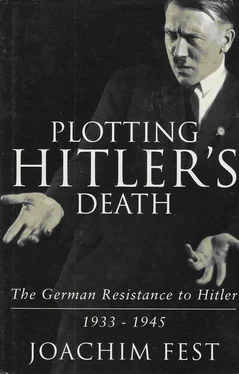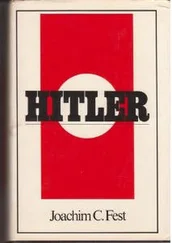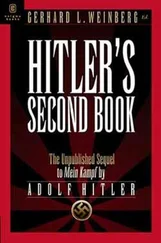The preceding is only a condensed account of the best-known of the assassination attempts. Although there were many other clandestine discussions and a number of attempts that also failed, little is known about them, because virtually all those involved were discovered and executed. It is said, for instance, that Stauffenberg attempted to kill Hitler on December 26, 1943, in the “Wolf’s Lair,” as Führer headquarters at Rastenburg was called. Stauffenberg’s original plan, apparently, was to blow himself up with Hitler, but Beck and Olbricht objected so vehemently that Stauffenberg agreed to spare himself. He was waiting in Hitler’s antechamber for their meeting to commence when he was informed that it had been canceled.
Be that as it may, it was at about this time that Stauffenberg first began to consider taking the assassination into his own hands. Only in this way, he felt, could he break the curse that seemed to haunt the resistance.
* * *
In retrospect it may seem that the inner strength of the resistance had already begun to ebb by late 1943 and early 1944 and that Tresckow’s failed plot in March 1943 was the turning point in this drama. If so, Stauffenberg joined too late, forced as he was to struggle not only against the Nazi regime but also, to a greater extent than any of his predecessors, against mounting exhaustion and pessimism among the conspirators. Moreover, the state security apparatus began taking greater interest in the opposition after the raid on Military Intelligence, and bad news seemed to pour in from all directions.
Tresckow, however, remained determined to escape the backwater in which he found himself as an infantry commander and to improve his chances of gaining access to Hitler. In December 1943 he contacted his old regimental comrade General Rudolf Schmundt with a proposal to establish a department of psychological and political warfare at Führer headquarters, with himself as head. Tresckow’s “negative attitude” had become so widely known in the meantime, however, that Schmundt, the chief of army personnel, who was still well-disposed to his old friend, quietly let the matter drop. Tresckow also applied to become General Heusinger’s delegate in the OKH operational section but failed at that, too, apparently for the same reason. Heusinger only glanced at the letter, which Schlabrendorff delivered to him, before saying, “It doesn’t require an answer.” Tresckow also wrote to Colonel Stieff, who was still hesitating, begging him to take action at last. When he read the letter, Stieff “burst into approving laughter” and promptly destroyed it. 36
The conspirators suffered another blow in December when Carlo Mierendorff died in a building that collapsed during a bombing raid on Leipzig. According to witnesses, his final word, shouted from the burning cellar, was “Madness!” 37At about the same time the Gestapo honed in on members of an opposition group that had formed around Hanna Solf, the widow of the former German ambassador to Tokyo, and that provided support for people who were persecuted or living underground. Suspicion was probably aroused by the involvement of three officers from Military Intelligence: Nikolaus von Halem, the former legation secretary Mumm von Schwarzenstein, and Otto Kiep. The Security Service had begun systematically to put all Military Intelligence officers under surveillance in the hope that Canaris’s department would continue to crack and could then be absorbed into the expanding empire of the SS. On January 12, 1944, the members of the Solf Circle were arrested while at afternoon tea. One week later Helmuth von Moltke, who had attempted to warn Otto Kiep of the danger, was also picked up. The flood of bad news continued on February 11, when Canaris was dismissed from his job and imprisoned in the Lauenstein fortress, while Himmler’s henchmen, Ernst Kaltenbrunner, Walter Schellenberg, and Heinrich Müller, began to dismantle Military Intelligence piece by piece.
The ascendancy of Heinrich Himmler and the SS state led to a bizarre episode that concluded just as the new year began. Spurred by the repeated failure to overthrow the regime by force, Johannes Popitz had hit on the idea of encouraging a “palace revolution” or at least of exacerbating the tensions that existed among the leading members of the Nazi Party in order to speed up the already perceptible disintegration process. At first Popitz considered approaching Göring, Hitler’s designated successor and the prime minister of Prussia, in whose cabinet he still officially sat as minister of finance. He soon concluded, however, that Göring had become too self-indulgent and corrupt, too preoccupied with his flamboyant social life to function even as the figurehead of a serious uprising. Popitz turned therefore to none other than Heinrich Himmler in his perilous venture to destroy the regime from within.
Popitz had no reason at all to assume that Himmler would prove amenable. After a brilliant early career Popitz had become state secretary in the Ministry of Finance while still quite young, working for a time under the Social Democratic minister Rudolf Hilferding, whom he helped escape Germany after the Nazis seized power. His close bonds with Hilferding may explain why he leaned toward a policy of strong governmental control of the economy, which recommended him to some of the younger members of the Kreisau Circle despite his reputation as a “reactionary old Prussian.” Having made friends with Hans Oster in 1935, Popitz had become deeply involved in the resistance to Hitler even before the war; indeed as a sign of protest against the persecution of Jews, he submitted his resignation as minister to Goring in November 1938, explicitly requesting that Hitler be informed of the reasons. He never received a response, however, and in the end remained in office.
Popitz was also acquainted with Carl Langbehn, who had joined the opposition in the late 1930s. It turned out that Langbehn knew Himmler personally both as a lawyer and as a neighbor in the Dahlem neighborhood of Berlin. Through this connection Popitz now contacted the powerful chief of the SS, who had recently been appointed minister of the interior. They met on August 26. In a conversation conducted with Machiavellian cunning, in which he skirted the edge of the abyss more than once, Popitz suggested that no one but Himmler could resolve the desperate situation that had befallen the regime both at home and at the front. Such a suggestion was not totally devoid of promise, as the clear-headed, coolly calculating SS leaders had themselves already begun to entertain serious doubts about whether Germany could win the war and to wonder how their interests might best be served. Popitz avoided referring directly to “overthrowing” Hitler, although that was his ultimate aim, instead making oblique references to “lightening the burden” the Führer had to bear. In general Popitz gained the impression that Himmler had long doubted that Germany could win the war. At the end of their conversation the two agreed to meet again soon.
This second meeting never took place. The next month Langbehn was arrested after his contacts with the Allies through Swiss intermediaries were exposed. Popitz found himself increasingly marginalized within the civilian resistance despite the leading role he had played until this point. His daring initiative was, of course, an act of desperation, predicated on the belief that Himmler could be elbowed aside after he had served his purpose. That idea seemed an eerie echo of the illusions of the spring of 1933, when it was thought that Hitler could be controlled once in power. But Popitz’s greater error was his failure to realize that the SS leader did not act independently and exercised only delegated authority. Furthermore, he overlooked how damaging it would have been for the opposition to be maintaining contact, for whatever reason, with a man who was widely believed to epitomize Nazi terror. Gerhard Ritter was not far off track when he described Popitz as the type of intellectual who has “pure intentions but few sure political instincts.” It was this shortcoming that gave rise to the general feeling within resistance circles that Popitz had overstayed his welcome in the role o leader. At any rate, Goerdeler felt that Popitz had gone too far and, after hesitating at first, decided that he didn’t want to hear so much as a word about the conversation with Himmler At Stauffenberg’s urging Goerdeler, too, abandoned the finance minister. The circle had been “blown apart,” Hassell wrote in late February. “Everything is going to hell.” 38
Читать дальше




![Traudl Junge - Hitler's Last Secretary - A Firsthand Account of Life with Hitler [aka Until the Final Hour]](/books/416681/traudl-junge-hitler-s-last-secretary-a-firsthand-thumb.webp)







